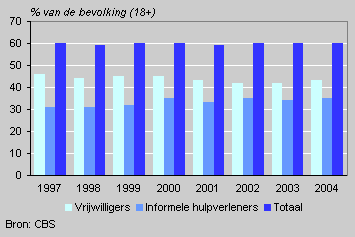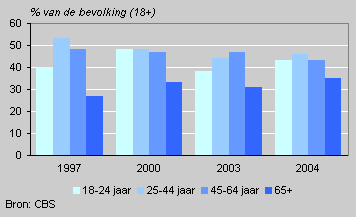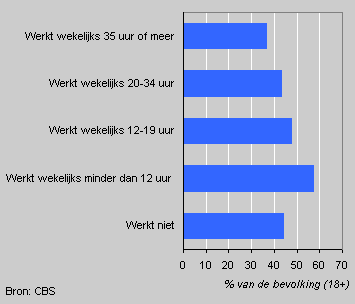More over-65s active in voluntary sector

In the period 1997-2004 there was an increase in the number of over-65s active in the voluntary sector and the informal care sector. In the rest of the adult population the number of informal care providers also increased but the number of voluntary workers decreased.
Voluntary workers and informal care providers

Six in ten adults active in voluntary and informal care sectors
The participation rate of persons aged 18 years and older active in the voluntary sector slightly diminished in the period 1997-2004. In the late 1990s the participation rate in the voluntary sector was 45 percent, in 2004 it had fallen to 43 percent. The decrease was compensated for by an increase in informal care providers. The total share of adults active in both sectors remained unchanged: six in ten adults are active in the voluntary sector as well as in the informal care sector.
Participation rate in the voluntary sector

More older voluntary workers
The percentage of persons over the age of 65 who were active in voluntary work rose from 27 percent in 1997 to 35 percent in 2004. The number of persons aged 65-74 who were active in the voluntary sector was twice as high as those in the age category 75 and older.
In the age groups 25-44 and 45-64 the percentage of volunteers declined. The participation rate among young people fluctuated so much that there is no prevailing upward or downward trend.
Participation rate in the informal care sector

More old as well as young informal care providers
The number of over-65s providing help to friends, relatives and acquaintances was higher in 2004 than in 1997. This type of aid also grew among younger people, mainly in the late 1990s.
Voluntary work and economic activity

Full-timers least active
Full-timers are least active in the voluntary sector, if age and gender disparities are taken into account. The participation rate is also relatively low among persons with paid jobs working 20-34 hours a week and, most strikingly, also among people who do not work at all. People with small jobs are by far the most active voluntary workers, followed by part-timers working 12-20 hours a week. The weekly amount of leisure time obviously plays a part, but is not a decisive factor. In the informal care sector more or less the same pattern is found.
Ferdy Otten